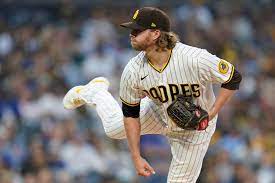The Braves announced the signing of reliever Pierce Johnson to a $14.25 million, two-year contract extension. (Atlanta is among the few teams that makes contract terms available to the public.) A few weeks away from free agency, Johnson is slated to receive consecutive $7 million contracts in 2024–2025 and is assured a $250k buyout on a $7 million team option for 2026. The contract’s average yearly value, for luxury tax purposes, is $7.125 million. John Boggs & Associates has Johnson as a customer.
Next May, Johnson, 33, made his Braves debut in a trade that sent minor league pitchers Tanner Gordon and Victor Vodnik to the Rockies before the deadline. At the time, it wasn’t an extremely well-known decision.
After agreeing to a $5 million free-agent contract with the team, the right-hander had a 6.00 ERA over 38 innings Colorado Johnson had punched out a quality 30.9% of opponents with the Rox, so he wasn’t without upside, but few would’ve anticipated how resoundingly he’d turn his season around.
The Missouri State product tossed 23 2/3 regular-season innings for Atlanta, allowing 0.76 earned runs per nine. His strikeout rate jumped more than five percentage points, as he fanned 36% of batters faced. His swinging strike rate spiked from a solid 12.3% to an elite 17.8% mark. He more than halved his walks and doubled his ground-ball percentage. Johnson pitched his way into high-leverage work and added three scoreless appearances in the Division Series.

Leaving Coors Field offers a partial explanation for the improved results, but it’s certainly not the entire story. Johnson has always had promising raw stuff, pairing a 96 mph fastball with a mid-80s power curve.
Upon landing in Atlanta, he dramatically upped the use of the breaking ball. Johnson turned to the hook nearly three quarters of the time as a Brave after deploying it in a near-even division with the fastball while in Denver. Given the results, it’s hard to find fault with that plan of attack.
The question is how much stock to place in two-plus months of dominance amid an otherwise inconsistent career.
Johnson had never shown anything near the level of control he did in Atlanta. He carried a career 12% walk rate in parts of six big league campaigns with the Cubs, Giants, Padres and Rockies before that trade. As a Brave, he handed out free passes to just 5.6% of opponents.
Johnson has flashed solid ability before, albeit never to the level he demonstrated in Atlanta. He turned in a 3.22 ERA over 58 2/3 frames with San Diego three seasons back. His 2022 campaign was derailed by forearm tendinitis that kept him to 15 appearances, setting the stage for his rebound deal with Colorado. Now, he has locked in the strongest guarantee of his career.
Given that Johnson is getting paid at the lower end of the market rate for good setup arms in their mid-30s, it still has the potential to be a good bargain for the Braves. Adam Ottavino signed a $14.5 million contract with the Mets last offseason, but Chris Martin signed a $17.5 million deal over two years with the Red Sox.
Two years ago, Ryan Tepera ($14M) and Joe Kelly ($17M) signed comparable deals to begin their age-34 campaigns.
The Braves’ bullpen is strong; it ranked seventh in strikeout percentage (25.9%) and 11th in ERA (3.81).
With Brad Hand, Kirby Yates, Collin McHugh, and Joe Jiménez reaching free agency and Joe Jiménez entering a variety of option scenarios, they were likely to lose a couple players from the group.
The team might reject their options for McHugh and Hand, and there’s a chance they’ll pass on Yates’ net $4.5 million call.
Re-signing Johnson means that he will be available to line up Raisel Iglesias alongside A.J.
Minter and possibly Nick Anderson or Tyler Matzek. It appears that Alex Anthopoulos, president of baseball operations, and his front office are prioritising bolstering the middle bullpen.
The Braves have guaranteed deals of up to $138 million for the upcoming campaign. The arbitration claim might increase by about $30 million. Estimates from arbitration put Roster Resource’s luxury tax amount in the $206 million area, or around $30 million less than the $237 million base threshold for the next year.
With a player salary of about $203 million when the organisation started 2023, there should be some short-term flexibility left. Offseason objectives might include strengthening the pitching staff, adding to the bullpen, and perhaps replacing Eddie Rosario in left field.
Leave a Reply